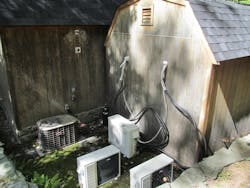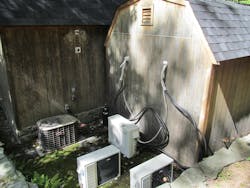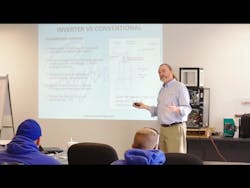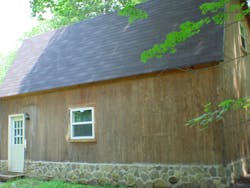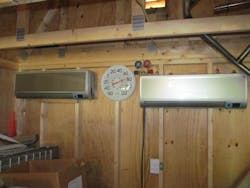Sizing mini split systems — Don’t oversize, choose the right equipment
A question I pose to the attendees of each mini split class I conduct is: Can you oversize an inverter ductless mini split system? Before you start writing your reply to what I’m sure you think is an obvious answer, let me save you the effort — yes — the answer is yes, of course you can!
Gerry Wagner’s testing lab for Comfort-Aire mini split products.
Now, with that out of the way, let me address why I pose the question at all if it’s so obvious.
We need to start with the anatomy of an inverter system. An inverter compressor can run at 3,600 RPM like every other compressor in HVACR equipment, but the difference is that it doesn’t have to.
Let me digress a moment… I'm a “wet-head” by birth. Being from the New Jersey and New York area, hydronics is the first HVACR subject you learn about, and then air comes later. When I started in the boiler biz back in the 1970s, we made a lot of different boilers: 50,000 Btuh, 75,000 Btuh, 100,000 Btuh, 125,000 Btuh, 150,000 Btuh, and on and on. Today boiler companies, for the most part, make one boiler, a modulating boiler that can down fire to as low as 50,000 Btuh and modulate up all the way to 150,000 Btuh. If you install this boiler in a home with a heat loss of 100,000 Btuh it doesn't short-cycle because it will never produce anything over 100,000 Btuh. Why? Because it measures indoor and outdoor ambient air temperature and fires the boiler accordingly.
Now you can take that old, oversized non-modulating 150,000 Btuh boiler, in a home with a heat loss of 75,000 Btuh, and stop it from short cycling by adding indoor/outdoor reset to the control system. Instead of heating the water up to 180°F even when the outdoor temp is 50°F and you just need to take the chill off, the control will fire the boiler only up to the temperature required to meet the heat loss of the home based on the outdoor air temperature. There would be some mechanical changes required, specifically a bypass from the boiler supply to the return to make sure a minimum return temp came back to the boiler to prevent thermal shock. New condensing boilers don't require a bypass as the lower the return temperature the more efficient they run.
So why am I giving you the Hydronics 101 lesson? Well, because the same principle applies to an inverter compressor.
Wagner conducts a course sponsored by Comfort-Aire and Heat Controller Inc.
The inverter compressor does not start at 3,600 RPM and then ramp down as the system finds the set point programmed by the homeowner. It starts at the lowest RPM and ramps up. If the actual room temp and the setpoint are only a few degrees apart, then the compressor will never come anywhere near full capacity. Like the modulating boiler, the inverter system senses both indoor and outdoor temperatures and applies power to the compressor accordingly, (the compressor is the burner, if you will).
The test lab
I can prove it very easily. My test lab here in New York is a 10-ft. x 20-ft. prefabricated garage where Itest mini split products on a consistent basis with multi zone and single zone inverter systems, both cooling and heating. I also have a larger building on my property, which houses my Internet-based boiler parts businesses, www.CelticParts.comand www.PulseParts.com.
The building that houses Wagner’s boiler replacement parts businesses,
www.PulseParts.com and www.CelticParts.com.
This building contains radiant floor heating, (slab on the first floor, joists on the second), with a Pulse condensing boiler and a small duct high velocity air conditioning throughout. [Wagner’s home is also heated via radiant flooring, a thermal solar system for domestic hot water, and an oil fired boiler is used as the heat source, plus, small duct high velocity for air conditioning.]
A recent equipment test had me install a single 12,000 Btuh inverter ductless system in the lab. Rather than short cycle as you would expect, what happens is the system rarely shuts off. The compressor will initially, (over a three minute period, if needed), ramp up to full capacity and get the room to the programmed set point and then you will see the compressor ramp down to a minimum running RPM. If the fan is on auto, it will do the same. The compressor may shut down completely and the controls programmed into the equipment will keep the compressor off for a minimum of three minutes and then it takes another three minutes for the compressor to come back up to full capacity. A minimum cycle (if it existed) could be no shorter than three minutes.
Inside the lab two 9K evaporators are tested.
You can further increase the run cycles by placing the evaporator fan in the manual mode and operating it at the lowest speed.
What always has to be considered when dealing with inverter ductless mini splits is the range of operation that the system will provide. Unlike a conventional system that only knows two performance points, on and off, the inverter offers a range of performance.
A 9,000 Btuh inverter evaporator will give you an operating performance range of approximately 2,000 Btuh to 11,000 Btuh of cooling.
A 12,000 Btuh inverter evaporator will give you an operating performance range of approximately 3,000 Btuh to 13,000 Btuh of cooling.
An 18,000 Btuh inverter evaporator will give you an operating performance range of approximately 7,000 Btuh to 23,000 Btuh of cooling.
Two ways to oversize
Let’s look at an example. If you install a 9,000 Btuh inverter evaporator in a room that has a heat gain of 5,000 Btuh, will it ever produce 9,000 Btuh? No! It will ramp up to 5,000 Btuh and satisfy the set point programmed by the homeowner and then maintain that set point thereafter.
So, with this in mind, back to my original question: can you oversize an inverter ductless mini split system? Well, I believe there are two ways to oversize utilizing an inverter mini split. The first is the obvious capacity oversize.
Let’s use the same example of a room with a 5,000 Btuh heat gain. If you install an 18,000 Btuh inverter evaporator in that room, are you oversized? Hell, yeah! The low end of the performance range of an 18,000 Btuh inverter evaporator is 7,000 Btuh — more than the total heat gain of the room.
Where I see installers make a less obvious mistake in sizing inverter mini splits is with this scenario. Again, the room with the 5,000 Btuh heat gain, but now we have an installer who decides to install a 12,000 Btuh evaporator in the room saying to himself, “It’s an inverter, it won’t ever go up to 12,000 Btuh because the room only needs 5,000 Btuh … so what’s the harm?”
He is right. Under normal conditions the unit will never go beyond 5,000 Btuh, but the harm is that his competitor who makes the more accurate choice of a 9,000 Btuh evaporator for the same room will get the job based on equipment cost alone!
Keep in mind, that the appropriate 9,000 Btuh evaporator will still allow an additional 6,000 Btuh of capacity beyond the room’s calculated heat gain of 5,000 Btuh should your customer decide to have a keg party in the room on the 4thof July and invite all his or her sweaty friends!
I’m a believer in inverter mini splits for so many reasons, in so many applications, but we still need to use our skills to make sure we are choosing the right equipment for each application.
Gerry Wagner is an instructor for ESPCO Inc. Gerry has 32 years in the HVACR industry and conducts classes throughout the U.S. and Canada on related subjects. You can see more of Gerry’s activities at www.ESPCOtraining.com.
